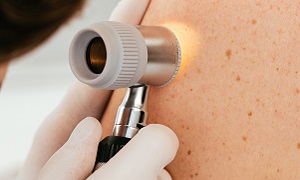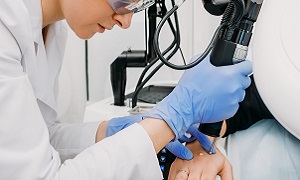Best Doctors in India for Cancerous Moles Treatment
Best Hospitals in India for Cancerous Moles Treatment
- City: Mumbai, India
Hospital Highlights:
- Fortis Hiranandani hospital was established in 2007.
- The hospital is an advanced tertiary care, multi-specialty hospital equipped with 149 beds.
- The hospital is equipped with a super ICU to provide emergency medical care to critically ill patients.
- The hospital is NABH accredited.
- The critical care facility in the hospital is augmented with the state-of-the-art facilities that facilitate speedier diagnosis and efficient monitoring.
- The hospital provides specialty medical services in cardiology, orthopedic science, pediatric science, neurology, diabetic care, urology, nephrology, ENT, obstetrics, gynecology, cosmetic surgery, bariatric surgery, neuro and spine care.
- City: Gurugram, India
Hospital Highlights:
- W Pratiksha Hospital, Gurugram, is one of the best hospitals in the NCR region. It is also a top hospital in India for IVF. Since its inception, the hospital has performed over 5500 successful IVFs. The hospital also specializes in gynecology.
- With over 20 years of experience in providing quality healthcare, the hospital is known as one of the most trusted and valued health providers in India.
- Equipped with world-class medical facilities and advanced technology, the hospital’s doctors and clinicians also have a track record of delivering excellent results. The hospital is also known for focusing on preventive well-being as much as on curative treatment.
- The hospital has earned the trust of its patients, by providing the best available treatments at affordable costs.
- City: Gurugram, India
Hospital Highlights:
- Paras hospital was established in 2006 and is the 250 bedded flagship hospital of Paras Healthcare.
- The is supported by a team of doctors of international and national repute.
- The hospital is NABH accredited and also the first hospital in the region to have a NABL accredited laboratory.
- The hospital provides specialty medical services in around 55 departments including Neurosciences, Joint Replacement, Mother & Child Care, Minimal Invasive Surgery, Gynecology and Obstetrics, Ophthalmology, Dermatology, Endocrinology, Rheumatology, Cosmetic and Plastic surgery.
- The hospital is equipped with state-of-the-art technologies.
- City: Kolkata, India
Hospital Highlights:
- Fortis Hospital, Anandapur, Kolkata is a world-class super-speciality equipped with the latest technologies in the medical world.
- The hospital is NABH accredited.
- This state-of-the-art facility specializes in cardiology and cardiac surgery, urology, nephrology, neurosciences, orthopaedics, digestive care, emergency care and critical care.
- The hospital, governed by integrated Building Management System (IBMS), has a pneumatic chute system, for quick vertical and horizontal transportation between floors, facilitating speedy transfer of patient specimens, documents, reports, and medicines to the concerned departments.
- The hospital also has a nephrology department with over 28 advanced dialysis units.
- City: Mumbai, India
Hospital Highlights:
- SL Raheja hospital is a 140-bed multi-specialty tertiary care hospital that is being managed by Fortis Healthcare Ltd.
- The hospital is a benchmark in healthcare and medical facilities in the neighborhood of Mahim & the western suburbs.
- L.Raheja Hospital, Mahim has one of the most effective ICU and Casualty care services.
- The hospital provides specialty medical services in Cardiology, Oncology, Neurology, Orthopedics, Mother & Child Care, and in Diabetes.
- City: Mumbai, India
Hospital Highlights:
- Wockhardt Hospitals were established in the year 1973, originally called First Hospitals and Heart Institute.
- Wockhardt Hospitals are super specialty health care networks in India, nurtured by Wockhardt Ltd, India’s 5th largest Pharmaceutical and Healthcare company.
- Wockhardt Hospitals is associated with Partners Harvard Medical International, an international arm of Harvard Medical School, USA.
- Wockhardt Heart Hospital performed India’s first endoscopic heart surgery.
- The hospital has a state-of-the-art infrastructure equipped with the latest technologies and modern equipment.
- It has special Centers of Excellence dedicated to the major specialties to provide hassle-free and high-quality clinical care.
- City: Gurugram, India
Hospital Highlights:
- The CK Birla Hospital in Gurugram is a NABH-accredited multi-specialty hospital.
- The hospital strives to increase the quality of healthcare by focusing on UK NHS nurse and midwife training requirements. Policies and practices derived from the National Institute for Health and Treatment Excellence (NICE) recommendations in the United Kingdom ensuring that a strong focus on safety, high-quality clinical care, and sanitation is maintained.
- The hospital’s cutting-edge technology and facilities allow for real-time communication and seamless collaboration among caregivers, ensuring accuracy and the best possible results. Those with foreign experience and accreditations make up part of the hospital’s team of clinicians.
- City: Ahmedabad
Hospital Highlights:
- As a member of the Apollo Hospitals Group, Apollo Hospitals International Limited, Ahmedabad is one of the most popular and sought-after medical facilities in Gujarat.
- Through its 6 Centres of Excellence and various affiliated branches, which cover all specialties and subspecialties, the hospital provides the most advanced clinical services.
- Since its inception in 2003, the hospital has been providing each patient with the most up-to-date medical equipment and state-of-the-art technology.
- With more than 150 successful organ transplants, including liver and renal transplants, the facility has been able to build a strong and extensive organ transplant program.
- In addition to performing 600 surgeries and caring for over 1800 patients on an IP basis, the hospital sees more than 18,000 patients on average in the outpatient department.
- With one of the biggest cardiology teams in the area, the hospital provides state-of-the-art regional care treatment in Cardiac Sciences.
- Additionally, the hospital offers a broad range of Neuro Interventional techniques to help stroke patients recover more quickly.
- City: Noida, India
Hospital Highlights:
- Jaypee Hospital is the flagship hospital of the Jaypee Group.
- This hospital has commissioned 525 beds in the first phase and has been planned and designed as a 1200 bedded multi-specialty facility.
- It holds the accreditation of the NABH and NABL.
- The hospital has state-of-the-art infrastructure equipped with the latest technologies and modern equipment like 64 Slice PET CT, Dual Head 6 Slice SPECT CT, Gamma Camera, and Da Vinci Robotic Surgery for comprehensive robotic surgical solutions.
- It has special Centers dedicated to the major specialties to provide hassle-free and high-quality clinical care.
- City: Mumbai, India
Hospital Highlights:
- Reliance Hospital is one of the best super-specialty care hospitals in Navi Mumbai.
- The main purpose of this hospital is to become a trustworthy place for the best health and hope for society. The hospital is well connected to the suburbs of Mumbai and Navi Mumbai.
- The hospital has various specialty departments, viz., Accident & Emergency, Anesthesiology, Dental Services, Dermatology, Diabetology, Dietetics Nutrition, Endocrinology, ENT, Gastroenterology, General Surgery, Gynaecology And Obstetrics, Hepato Pancreato Biliary Surgery, Infectious Disease, Internal Medicine, Interventional Radiology, Laboratory Medicine, Minimal Access Laparoscopic Surgery, Nephrology, Neurosciences, Opthalmology, Orthopaedics, Paediatrics, Pain Management Palliative Care, Physical Medicine Rehabilitation, Plastic And Reconstructive Surgery, Psychiatry, Pulmonary Medicine, Radiology, Rheumatology, Transplant, Urology Andrology, Vascular Surgery
Cancerous Mole
Cancerous mole is typically a new mole or an existing one, which has gone through a few changes. A cancerous mole is also known to be the most common sign of melanoma of the skin. Every new or changing mole, however, is not cancerous, and therefore, it is better to keep track of the moles.
Melanoma is not the most common form of skin cancer, but it is known to be the most serious one. This is due to the fact that it can spread very fast to other parts of the body, and make treatment difficult and thus resulting in a poor outlook.
These moles may occur anywhere in one’s body, and the appearance can also vary in shape and size.
Getting an early diagnosis and receiving proper treatment as soon as possible, is important, and it can improve the outlook for people having melanoma. This is why proper vigilance is important as well as regularly checking the skin.
Symptoms
Identifying a cancerous mole in the early stages of melanoma can be a little difficult. Due to this reason, people should consider checking their skin regularly for signs of any change, such as a new mole or a change in the appearance of any existing moles.
If a person suspects that a mole might be cancerous, it is important for them to see their dermatologist for a proper diagnosis.
Some of the symptoms that you should be aware of include the following:
- Any changes to the skin, such as a new mole or a change in the color, size, and of an existing mole
- A mole that has a shiny, waxy, smooth, or pale appearance
- A firm, red lump that bleeds or appears crusty
- A mole that does not heal or becomes painful or tender
- A mole that gets itchy or starts to bleed
- A flat, red spot that can be rough, dry, or scaly
You can follow the ABCDE examination rule as well, to check for potentially cancerous moles. This rule describes five simple characteristics of early melanoma. These features include the following:
- Asymmetry: One half of a cancerous mole is generally likely to look different as compared to the other half.
- Border: The edges might be ragged, notched, or blurred rather than smooth.
- Color: They may contain uneven colors and shades, which can be black, brown, or tan. Some might even include white, pink, red, grey, or blue areas
- Diameter: Cancerous moles generally change in size, and usually grow larger. If a mole gets larger than 6 millimeters, it might be cancerous.
- Evolving: A change in the appearance of a mole over weeks or months can also indicate that it is cancerous.
You may also want to remember that only around 20-30% percent of melanoma cases arise from a pre-existing mole. The majority presents as a new mole.
Causes
Scientists are still trying to understand the exact cause of cancerous moles. The most common reason is believed to a combination of genetic and environmental factors.
Excessive exposure to UV light is known to be the most common cause of cancerous moles. The main source of UV light is sunlight, as well as artificial sources of light, which includes tanning beds, as well as other gadgets that produce UV light.
People who have atypical mole syndrome are usually at high risk of developing this condition. The syndrome is associated with the following three characteristics:
- More than a hundred moles
- One or more moles that are 8mm or larger in diameter
- Multiple cancerous moles
Diagnosis
You should be able to detect the symptoms of a cancerous mole by using the ABCDE rule and regularly examining your skin for any new and existing moles.
People should also try to check all the areas of their skin, which includes their back and other areas which might be difficult to see without any assistance. You can use a mirror or your phone camera, or ask a friend or family member to check it for you.
If you are having concerns or worries about a mole, then you should see a dermatologist, who can use microscopic or photographic tools in order to examine a mole in more detail. Dermatologists are specially trained to identify abnormal moles as well as melanomas. However, even with their years of training, sometimes this can prove to be difficult.
If your dermatologist suspects a cancerous mole, he/she might order a biopsy. This procedure involves a healthcare professional taking a sample of a mole and sending it to the laboratory for examination.
Treatment
Treatment for a cancerous mole is mostly the same as other cancers. However, unlike cancers of the internal organs, it will be easier to assess the cancerous tissue and remove the mole using surgery. Surgery is therefore the most common treatment option for most cancerous moles.
The procedure generally involves removing the mole along with some of the surrounding non-cancerous tissue around it. In certain cases, when a person has received an early diagnosis, surgery might be a sufficient remedy for treating the cancerous mole. If the mole covers a large area of the skin, a skin graft might also be required after the surgery.
Generally, a surgeon is ‘going to perform the excision while a person is under local anesthesia. This means that the person is conscious during the procedure, though they will not be feeling any pain, as the affected area will be numbed.
If there is any risk that your cancer has spread into your organs, blood, or your bones, then a doctor might perform a further examination, such as lymph node surgery, biopsy, radiologic studies, etc.
If your cancer has spread, then a doctor is going to perform a few other procedures which can include any of the following:
- Radiation Therapy
- Chemotherapy
- Targeted Therapy
- Immunotherapy














